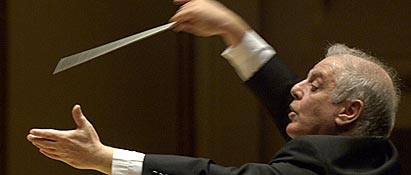From the CHICAGO TRIBUNE, June 18, 2006:
Curtain call for the maestroBarenboim bows out after 15 years as CSO director

By John von Rhein and Charles Storch
Tribune staff reporters
Daniel Barenboim wanted to go out with the biggest splash possible, and he got his wish.
With a sold-out Orchestra Hall resounding with the lofty paean to universal brotherhood known as Beethoven's Ninth Symphony, the Barenboim era at the Chicago Symphony Orchestra came to a close at about 10:20 Saturday night.
There were no final speeches, but the 63-year-old Barenboim preceded the performance of the Beethoven's Ninth with brief reflections on his 36-year association with the orchestra. This was his final concert as music director, a post he is leaving after 15 seasons.
"I will always treasure the musical and human trust they gave me through all these years," he said, adding that he felt "deep joy and pride" at the musicians' calling him Honorary Conductor for Life.

At the end, he applauded the orchestra and shook musicians' hands before acknowledging the roar of the crowd. The audience broke into rhythmic applause, calling him back for repeated bows, each louder than the previous...
In fact, many musicians were applauding and cheering as loudly as the audience. The ovations began at the very start of the evening, as Barenboim entered and sat down at the piano to conduct Beethoven's "Choral Fantasy."
All seats had been snapped up by subscribers and patrons by April 2005.
But some hopeful fans stood outside the hall seeking a ticket. Among them was Christopher Devine, 23, of Chicago, waving a fan of $20s. "I would go up to $200 for a ticket," he said. "That's all I brought."The audience included notables from the worlds of music, business and politics, including former World Bank President James Wolfensohn. Entering the hall, actor Ed Harris noted he is in a new film about Beethoven and was "very excited about hearing the music."
For CSO violinist Tom Hall, the Barenboim years were especially laden with emotion because they coincided with his own time in the orchestra. Hall joined the Chicago Symphony in 1970, when Barenboim debuted as a CSO guest conductor, and the violinist is retiring from the ensemble the same weekend the music director is leaving.
"It has been an honor, privilege and pleasure to belong to this wonderful orchestra for 36 years and, during that time, to work with this most remarkable musician," Hall said. "I am in awe of his keyboard virtuosity, extensive knowledge of music history and theory, probing intellect, courageous humanitarianism, and sharp and ready wit."
 Caption: Christopher Devine of Chicago waves cash outside Symphony Center in an effort to get a seat for Daniel Barenboim's last performance with the CSO as its musical director. He finally succeeded.
Caption: Christopher Devine of Chicago waves cash outside Symphony Center in an effort to get a seat for Daniel Barenboim's last performance with the CSO as its musical director. He finally succeeded.
 From the July 3 issue of
From the July 3 issue of 







